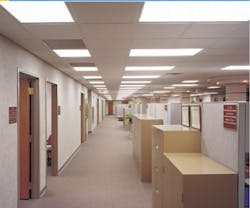This fact sheet provides guidance on the various factors to consider when deciding on an LED upgrade for a fluorescent troffer system.
Lighting accounts for roughly 20% of the electricity use in a typical commercial building, and the workhorse in these indoor applications has been the linear fluorescent lamp. In 2010, lighting systems using linear fluorescent lamps accounted for over 75% of the lighting service in commercial buildings. Recessed troffer luminaires, commonly available in 1x2, 2x4 and 2x2 sizes, provide the majority of this lighting. The total installed stock of common linear fluorescent luminaires in the United States is estimated to be over 960 million luminaires.
Although the installation of LED troffer-style luminaries jumped from an estimated 40,000 units in 2010 to nearly 700,000 units in 2012, LED luminaires still represent less than 0.1% of the troffer luminaires installed in commercial buildings. It may be possible to achieve over 25% energy savings on a national level if LED technology reaches its projected market penetration in troffer luminaires of over 65% by 2030. The energy savings on an individual project can be much greater than 25%. The related economic and environmental benefits are substantial. This fact sheet provides guidance on the various factors to consider when deciding on an LED upgrade for a fluorescent troffer system.
Published by the U.S. Department of Energy, January 2014.
